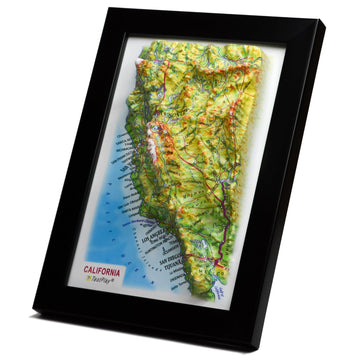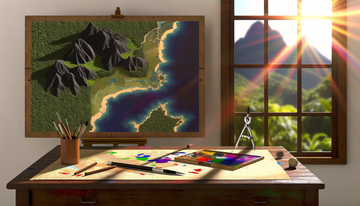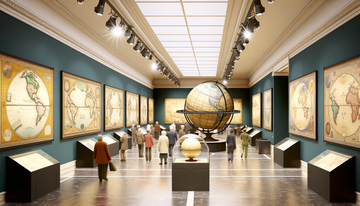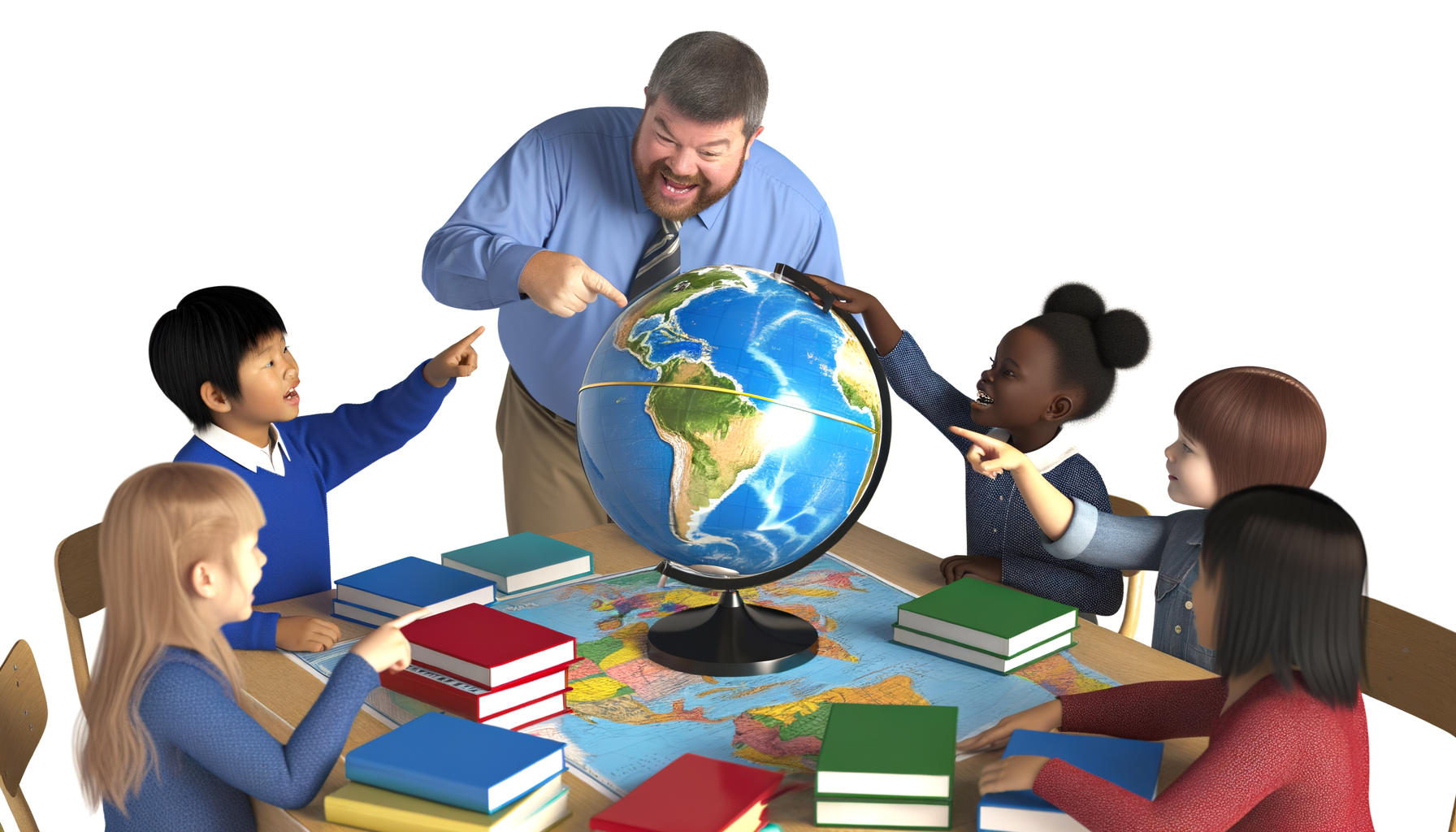Unlock Learning: The Educational Power of a Children's Globe
In an age dominated by screens, digital maps, and instant information, it might seem quaint to suggest that a physical globe holds significant educational value for children. We live in a world where searching for "Paris" on a phone yields photos, facts, and directions instantly. However, while digital tools offer incredible convenience and access, they often lack the foundational, tactile understanding that physical objects provide, especially for young, developing minds.
Navigating complex concepts like scale, relative distance, and the true three-dimensional nature of our planet can be challenging when confined to a flat, scrolling interface. This is where the humble children's globe shines, offering a unique and powerful gateway to geographical understanding and a host of other cognitive benefits. It's more than just a colorful decoration; it's a fundamental learning tool that can grow with your child.
This post will explore the many ways a children's globe contributes to a child's education, from building essential geography skills and developing spatial reasoning to fostering global awareness and sparking endless curiosity. We'll delve into why a globe is still an indispensable resource in the modern home and classroom, offering insights into its tangible benefits and providing a compelling case for its inclusion in every child's learning journey. By the end, you'll understand why investing in a good children's globe is an investment in your child's understanding of the world they inhabit.
Why Globes are Essential for Early Learning Foundations
The initial stages of learning about the world for young children often involve simple concepts: "Where are we?" and "What is out there?" A globe provides the perfect concrete answer to these fundamental questions in a way that flat maps simply cannot replicate. It presents the Earth as it truly is – a sphere – immediately establishing a correct mental model from the outset. This fundamental understanding is crucial for building all subsequent geographical knowledge.
The Foundation: Visualizing Our World as a Sphere
One of the most significant educational contributions of a globe is its accurate representation of the Earth's shape. Children primarily interact with flat surfaces – books, tables, screens, floors. Introducing a three-dimensional model of their home planet is a pivotal moment in their cognitive development regarding spatial understanding. They can see, touch, and turn the Earth, literally getting a feel for its spherical form.
This tangible interaction helps dispel the common misconception that the Earth is flat, a concept that can be surprisingly difficult for young children to fully grasp based solely on abstract descriptions or flat images. The globe makes the abstract concept of a sphere concrete and navigable. They can trace their finger over the surface, understanding that it curves, and that there's a "back side" to the world they cannot see all at once, requiring rotation. This simple act of physical interaction builds a powerful, correct initial model of the Earth's structure.
Mapping Continents and Oceans: A World of Discovery
Globes are visual treasure maps, clearly delineating the major landmasses – the continents – and the vast bodies of water that surround them – the oceans. The bright, distinct colors typically used on children's globes make it easy for young eyes to differentiate these large geographical features. Kids can quickly learn to identify the familiar shapes of North America, South America, Africa, Europe, Asia, Australia, and Antarctica.
More importantly, they learn the relative positions of these landmasses to one another and to the surrounding oceans, like the Atlantic, Pacific, Indian, and Arctic. Spinning the globe becomes an engaging activity, allowing them to see how the oceans connect the continents and how vast these watery expanses truly are. This visual and tactile reinforcement solidifies their understanding of basic global geography in a memorable way. Learning the names and locations of continents and oceans is a foundational step for understanding global relationships, history, and environmental systems later on.
Beyond Flat Maps: Understanding Scale and Relative Distance
While flat maps are essential tools for detailed regional geography, they inherently distort the size and distance of landmasses, particularly near the poles (a result of projecting a sphere onto a flat surface). A globe offers a more accurate representation of scale and relative distance across the entire planet. Children can see that Greenland isn't actually larger than Africa, a distortion often present on standard Mercator projection maps.
Using a piece of string or a flexible ruler, kids can measure the approximate distance between two points on a globe, understanding that a straight line across the globe is a great circle route, which is the shortest distance between two points on a sphere. This simple exercise introduces them to the concept of geographical distance in a realistic way, demonstrating that traveling from one continent to another involves traversing vast distances across oceans or land. It makes the world feel large yet interconnected, fostering a more accurate mental model of global spatial relationships.
Expanding Horizons: Concepts a Globe Unlocks
The educational utility of a children's globe extends far beyond simply identifying continents and oceans. As children grow and their understanding deepens, the globe can be used to introduce more complex and fascinating concepts about Earth science, global cultures, and even basic astronomy. It serves as a central reference point for discussing a wide range of topics, making abstract ideas more concrete and understandable.
Exploring Diverse Cultures and Places
A globe is a powerful tool for fostering curiosity about the world's people and places. Finding a country on the globe naturally leads to questions: "Who lives there?" "What language do they speak?" "What kind of animals are there?" "What food do they eat?" Connecting locations on the globe to stories, books, documentaries, or personal travel experiences brings geography to life in a meaningful way.
Learning about different cultures and ways of life broadens a child's perspective, encouraging empathy and global awareness from a young age. They can see where their ancestors came from, where missionaries serve, where products they use are made, or where significant historical events took place. The globe transforms from a map of physical features into a map of human stories and global interconnectedness, laying the groundwork for understanding diversity and global citizenship.
Introducing Earth's Movement and Axial Tilt
Many children's globes are mounted on a tilted axis, representing the Earth's actual tilt relative to its orbital plane around the sun. This seemingly simple feature is incredibly important for understanding fundamental Earth science concepts. The tilted axis is the reason we have seasons. While a full explanation might be complex for very young children, a globe provides the visual anchor for this concept later on.
Even without discussing seasons initially, demonstrating that the Earth spins (rotates) on this axis is easy and intuitive with a globe. This spinning motion is responsible for the cycle of day and night. By shining a flashlight (representing the sun) on one side of the globe and spinning it, you can vividly illustrate why one part of the world is experiencing daytime while the opposite side is in darkness. This hands-on demonstration makes an abstract astronomical concept tangible and easy to visualize.
Time Zones and the Day/Night Cycle
Building on the concept of rotation, a globe is the ideal tool for introducing the idea of time zones. As the globe spins, different parts of the world enter or leave the "daylight" area illuminated by the flashlight-sun. This naturally leads to the understanding that when it's noon where you are, it's a different time somewhere else on the globe. Some globes even feature lines indicating time zones, offering a visual guide.
Explaining time zones using a flat map is significantly more challenging and less intuitive. The globe's three-dimensional nature and ability to be rotated accurately model this phenomenon. This concept is important for understanding global communication, travel, and simply how interconnected yet temporally distinct the world is. It’s a practical application of geography and Earth science that the globe simplifies.
The Hands-On Advantage: Engagement and Retention
In an educational landscape increasingly filled with passive consumption of digital content, the tactile, interactive nature of a physical globe stands out. Children learn best by doing, touching, and exploring their environment. A globe offers a rich, hands-on learning experience that engages multiple senses and promotes active participation in the learning process. This physical interaction enhances memory retention and makes learning more enjoyable and effective.
Globes as Tactile Learning Tools
Picking up, spinning, and pointing to places on a globe is a fundamentally different experience from swiping or clicking on a screen. This physical engagement creates stronger neural connections related to the information being processed. Children can feel the weight of the globe (if small), trace the outlines of continents, and spin it to watch the world go by. Some globes even have raised relief, allowing children to feel mountain ranges and understand topography in a physical way.
This tactile interaction makes the learning process more memorable and personal. It transforms abstract geographical data into something concrete and real they can interact with. It encourages exploration and discovery through physical manipulation, which is particularly beneficial for kinesthetic learners. The simple act of spinning the globe can also be quite calming and mesmerizing, inviting longer periods of focused interaction.
Developing Spatial Reasoning Skills
Spatial reasoning is the ability to think about objects in three dimensions and to mentally manipulate shapes and spaces. It's a critical cognitive skill important for subjects ranging from math and science to engineering and art. Interacting with a globe directly develops spatial reasoning. Children learn to translate the 3D object into a mental map, understand relative positions in three-dimensional space, and visualize how rotating the sphere changes the visible parts of the world.
Compared to a flat map which requires translating 2D information into a mental 3D model, a globe presents the 3D model directly. This allows children to build a more accurate foundational understanding of spatial relationships on a global scale. Activities like finding the antipodes (the point on the opposite side of the Earth) or tracing a hypothetical journey across multiple continents directly engage and strengthen these crucial spatial thinking skills.
Igniting Curiosity and Imagination
Perhaps one of the most powerful educational benefits of a children's globe is its ability to spark curiosity and fuel the imagination. As children explore the globe, they encounter place names, vast oceans, and distant lands that can seem both mysterious and inviting. Finding a place like the Sahara Desert might lead to questions about camels and heat, while locating the Amazon Rainforest could inspire learning about unique animals and lush vegetation.
The globe provides a starting point for countless imaginative journeys and learning quests. Kids can pretend to sail across the Pacific Ocean, fly over the North Pole, or plan an imaginary expedition to Mount Everest. This imaginative play, rooted in geographical reality, makes learning fun and self-directed. It encourages children to ask questions, seek answers, and develop a lifelong interest in exploring the world and its diverse wonders.
Choosing the Right Children's Globe
Given the multitude of benefits, you might be considering adding a globe to your child's learning resources. With various options available, choosing the right one can enhance its educational impact and ensure it remains a valuable tool for years. Factors like age appropriateness, durability, and specific features should guide your selection process. The right globe will be an engaging and reliable source of information and inspiration for your child.
Types of Globes
Globes come in several types, each offering slightly different educational emphases. Physical globes primarily show geographical features like mountains, rivers, deserts, and elevation changes, often with raised relief to make topography tangible. Political globes highlight countries and their borders in different colors, along with major cities and capital cities, focusing on geopolitical information. Dual-purpose globes combine both physical and political features, sometimes showing one when unlit and the other when illuminated.
Illuminated globes have a light inside, serving as a lamp while also often revealing political boundaries when lit and physical features when unlit. This adds versatility and can be particularly engaging, especially for illustrating the day/night cycle. Interactive globes use technology, such as a smart pen that triggers audio responses (facts, national anthems, etc.) when touched to a specific location. These can be highly engaging, although the technology might become outdated over time compared to a traditional physical globe.
Features to Consider
When selecting a globe, consider its size and scale – larger globes show more detail but require more space. Durability is key, especially for younger children; look for sturdy bases and materials. The clarity and accuracy of the map details, including place names and boundaries, are essential for providing correct information. Consider the base type (desktop, floor stand) based on where it will be used and stored. For illuminated globes, check the power source and bulb type. For interactive globes, research the range of information provided and ease of use. Ultimately, the best globe is one that is age-appropriate, durable, accurate, and visually appealing enough to invite frequent interaction and exploration by your child.
Integrating the Globe into Learning Activities
A globe is not meant to be a static display item; its true educational value is unlocked through active use and integration into learning activities. Making the globe a regular part of playtime and study time encourages exploration and reinforces geographical concepts in a practical, engaging way. Here are some ideas for incorporating a globe into your child's learning routine, fostering curiosity and building knowledge through interactive play and directed learning.
Using the globe as a tool for games or as a reference point during reading or news discussions can transform abstract information into tangible understanding. It provides a visual anchor for discussing global events, historical movements, or the settings of stories. Here are a few ways to actively use a children's globe:
- Explore and Identify: Simply spend time spinning the globe and pointing out continents, oceans, and major countries. Ask your child to find specific locations or identify which continent is which. This builds foundational identification skills through repetition and visual association. Encourage them to share what they know or ask questions about the places they see.
- Continent Hopscotch or Ocean Tag: Turn learning into a game. Call out a continent or ocean name and have your child quickly point to it on the globe. Time them to add excitement or play "continent hopscotch" by asking them to touch different continents in sequence. This reinforces recognition and quick recall of global geography.
- Pinpointing Homes and Origins: Locate your own city, state, and country on the globe. Find the birthplaces of family members, or countries connected to your heritage. This makes the vastness of the world relatable by connecting it to personal history and identity. Discuss distances and travel involved.
- Tracing Journeys and Explorations: Use a string or follow lines of latitude and longitude (if marked) to trace the routes of famous explorers, historical migrations, or even fictional character journeys from books. This helps children visualize the scale and path of global travel throughout history and literature. It links geography to history and storytelling.
- Connecting to Animals and Habitats: As you learn about different animals, find their native habitats on the globe. Where do penguins live? Where are elephants found? This connects geography to biology and helps children understand how different climates and environments are distributed around the world. It makes learning about ecosystems tangible.
- Discussing World Events and Cultures: When news or conversations touch upon a specific country or region, find it on the globe. Discuss where it is located relative to where you are. Look up facts about its culture, landmarks, or people. This makes current events and cultural studies more concrete and understandable by providing geographical context.
- Understanding Day and Night (Illuminated Globes): Use an illuminated globe in a darkened room with a flashlight as the sun. Demonstrate the Earth's rotation and explain why different parts experience day and night simultaneously. This is a powerful visual aid for understanding Earth science concepts. Discuss how this affects communication across different parts of the world.
- Linking Geography to Stories: When reading books set in different parts of the world, locate the setting on the globe. Discuss the climate, landscape, and distance from your home. This enhances comprehension and brings the story's setting to life in a tangible way. It makes literary journeys feel more real.
- Simple Map Skills: While a globe isn't a flat map, it introduces concepts like the North and South Poles, the Equator, and potentially lines of latitude and longitude. Explain these basic geographical reference points using the globe as a visual aid. This lays the groundwork for understanding coordinate systems used on maps and GPS.
The Long-Term Value of a Globe
A children's globe is not a toy that will be quickly outgrown; it is a learning tool with remarkable longevity. Its utility evolves as the child's understanding and curriculum advance, remaining relevant and valuable from preschool through elementary school and even into adolescence. This enduring relevance makes a globe a truly worthwhile investment in a child's educational resources. It adapts to different levels of geographical inquiry.
A Learning Companion Through Different Ages
For a preschooler, the globe is a colorful ball representing the Earth, a tool for learning the names of continents through songs and simple pointing games. They learn the basic shape of our planet and distinguish land from water. In early elementary school, children can use the globe to locate specific countries, capital cities, and major mountain ranges or rivers, connecting names to locations and beginning to understand relative sizes and positions.
As children move into upper elementary and middle school, the globe becomes invaluable for understanding more complex concepts taught in geography, history, and science. They can use it to visualize historical trade routes, understand climate zones linked to latitude, study the path of ocean currents, or learn about tectonic plates and geological features. The same globe that taught them where Africa is can later help them understand the transatlantic slave trade or the formation of the Sahara Desert. Its simplicity allows for complex learning over time.
Fostering a Lifelong Interest in Geography and the World
Introducing a child to the world through a globe fosters a fundamental appreciation and curiosity about our planet and its inhabitants. This early, positive interaction with geography can cultivate a lifelong interest in learning about different cultures, global events, environmental issues, and travel. It provides a framework for understanding the interconnectedness of the world and our place within it.
In an increasingly globalized society, geographical literacy and a broad understanding of world cultures are more important than ever. A children's globe serves as a constant, accessible reminder of the vast, diverse, and fascinating world waiting to be explored. It encourages a mindset of discovery and global citizenship, preparing children to navigate and understand the complex realities of the 21st century. It's an investment in their worldview, not just their geographical knowledge.
Conclusion: The Enduring Value of a Children's Globe
While technology offers incredible access to information, the fundamental educational value of a physical children's globe remains undeniable. It provides a unique, tactile, and intuitive way for children to understand the true shape of our planet, grasp foundational geographical concepts like continents and oceans, accurately perceive scale and distance, and visualize complex ideas such as Earth's rotation and time zones. Beyond core geography, a globe sparks curiosity about diverse cultures, enhances spatial reasoning, and fosters a lifelong appreciation for the world.
A children's globe is far more than just a static piece of decor; it is an interactive learning companion that can grow with your child, supporting their education from basic identification in early years to understanding complex global systems in later ones. It serves as a constant invitation to explore, ask questions, and connect seemingly disparate pieces of global information. In a world that often feels abstract and distant, a globe makes the planet feel real, tangible, and navigable for young minds.
Investing in a high-quality children's globe is investing in a fundamental educational tool that offers enduring value. It encourages hands-on learning, stimulates imagination, and builds a strong foundation for geographical literacy and global awareness. So, consider adding this timeless resource to your child's learning environment. It's a simple step that can open up a world of discovery and learning, providing them with a tangible piece of the planet to hold, spin, and explore whenever their curiosity calls. The educational journey begins with a single spin.




